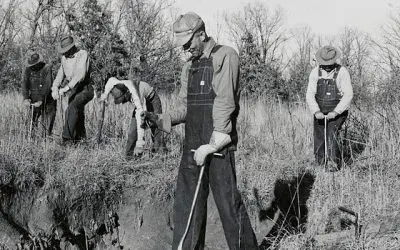As I learn more about technology advances in the forestry sector, I see many familiar ideas and some fascinating new stuff. Artificial Intelligence (AI) is reshaping industries everywhere, and Forest Restoration is no exception. The imperative for forestry leaders—whether in executive roles, product engineering, or strategy—is clear: AI can enhance operational efficiency, optimize restoration efforts, and drive sustainable outcomes.
But this isn’t just about deploying AI. It’s about using technology to transform a historically slow and labor-intensive process into one that is precise, scalable, and economically viable. Check out some of these ideas and examples of how AI is set to revolutionize our reforestation efforts.
- AI-Powered Reforestation: Speed and Precision – In traditional reforestation, workers plant trees one by one, often in rugged, inaccessible terrain. This makes scaling up operations difficult and time-consuming. Now, AI-powered drones can accelerate the process, making it possible to cover vast areas more quickly and accurately.
- AI’s Impact:
- AI-driven drones can plant seeds six times faster than humans, vastly improving reforestation efficiency.
- Algorithms analyze soil quality, terrain, and climate data to ensure that seeds are planted where they are most likely to thrive.
- AI can monitor seedling health in real-time, offering data-driven insights for timely interventions when growth stalls or environmental conditions threaten success.
- In the Wild: Land Restoration & Drone Seeding | Dendra
- AI’s Impact:
- Enhancing Biodiversity: Data-Driven Ecosystem Restoration – Restoring forests isn’t just about planting trees. It’s about rebuilding ecosystems that support a variety of plant and animal species. AI plays a key role in ensuring that the right species are planted in the right places, supporting biodiversity from the ground up.
- AI’s Impact: AI analyzes large environmental and species-specific data datasets, helping restoration teams select the best mix of native plants and animals for each site.
- Machine learning tracks the broader ecosystem’s response to new plantings, allowing restoration strategies to be adjusted as needed.
- AI helps prioritize key areas for restoration—such as wildlife corridors or carbon sinks—where interventions can have the biggest ecological impact.
- In the Wild: Restor for Enterprise | Restor.eco
- AI’s Impact: AI analyzes large environmental and species-specific data datasets, helping restoration teams select the best mix of native plants and animals for each site.
- Predictive Climate Analytics: Building Resilience – One of the major challenges in forest restoration is the unpredictability of climate change. How do you ensure that newly planted forests will thrive in a future defined by erratic weather patterns? AI offers predictive power by analyzing environmental data to forecast how forests respond to changing conditions, such as increasing temperatures or shifting rainfall.
- AI’s Impact
- AI-driven models can predict which species will fare better under different climate scenarios, allowing restoration teams to make proactive decisions.
- Restoration efforts can be adjusted based on these insights, ensuring that the species selected for planting are climate-resilient.
- Ongoing simulations allow for adaptive management so forest restoration can evolve in response to real-time environmental data.
- In the Wild: Terraware | Forest Management Software | Terraformation
- AI’s Impact
- AI and Carbon Credit Valuation: Monetizing Ecosystem Services – Forest restoration offers more than environmental benefits. It also presents financial opportunities through carbon credits earned by sequestering carbon in newly planted forests. However, calculating carbon sequestration accurately can be a challenge—this is where AI comes into play.
- AI’s Impact
- AI simplifies carbon credit valuation by analyzing satellite data, ground sensors, and aerial imagery for precise carbon storage measurements.
- Machine learning algorithms track carbon sequestration over time, allowing forest owners to generate reliable carbon credits.
- AI also optimizes restoration efforts to maximize carbon capture, offering dual ecological and financial returns.
- In the Wild: Pachama | Project Partner (Assess and track forest carbon projects)
- AI’s Impact
- Post-Restoration Monitoring: Ensuring Long-Term Success – Restoring a forest is the first step in a long process. For the restoration to be successful, continuous monitoring is essential. Traditional methods of monitoring, though, can be costly and ineffective. AI-powered platforms make this far more efficient by providing real-time data on tree health, pest infestations, and water availability.
- AI’s Impact
- AI offers real-time monitoring solutions that detect early signs of distress in newly planted trees, ensuring prompt action before problems escalate.
- Remote sensing and AI-driven data collection can track subtle changes in forest health, including disease or drought stress, improving the long-term success of restoration efforts.
- Continuous AI monitoring ensures that financial and ecological investments in forest restoration yield sustainable outcomes.
- In the Wild: How we measure impact: Monitoring and Evaluation – WeForest
- AI’s Impact
The Strategic Imperative: Why AI is Essential for Sustainable Forest Management
Data drives the future of forestry. AI is no longer a speculative tool—it is an operational necessity. Forestry leaders and entrepreneurs must adopt these technologies quickly enough to keep pace with growing environmental challenges and societal demands for sustainability.
At Talking Tree Ventures, we’re excited to support innovators taking on the challenge of restoring our planet’s forests. Join our mailing list to stay updated on new developments, share your thoughts in the comments, and explore more ways you can contribute to the future of sustainable forest management.





0 Comments